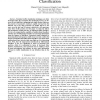Free Online Productivity Tools
i2Speak
i2Symbol
i2OCR
iTex2Img
iWeb2Print
iWeb2Shot
i2Type
iPdf2Split
iPdf2Merge
i2Bopomofo
i2Arabic
i2Style
i2Image
i2PDF
iLatex2Rtf
Sci2ools
GLOBECOM
2009
IEEE
2009
IEEE
Impact of Asymmetric Routing on Statistical Traffic Classification
Statistical traffic classification techniques are often developed under the assumption that monitoring devices can observe the two half-flows composing each traffic session. However, the practice of asymmetric routing is rapidly moving from the Internet core to its edge. Forecasts [1] predict that in a few years even the last legs of Internet connectivity will experience some form of this practice. In this paper we study the effects that asymmetric routing can have on statistical traffic classifiers. We do so by comparing the capability of unidirectional classifiers with the ones of bidirectional classifiers in extracting information from the features of half-flows. Numerical results obtained by processing three heterogeneous traffic traces not only confirm the obvious assumption that bidirectional classifiers work better than unidirectional ones, but also shed some light on a few interesting facts. First, that the improvement introduced by bidirectional classifiers is not very signifi...
Bidirectional Classifiers | Communications | GLOBECOM 2009 | Statistical Traffic | Statistical Traffic Classifiers |
| Added | 18 Feb 2011 |
| Updated | 18 Feb 2011 |
| Type | Journal |
| Year | 2009 |
| Where | GLOBECOM |
| Authors | Manuel Crotti, Francesco Gringoli, Luca Salgarelli |
Comments (0)

